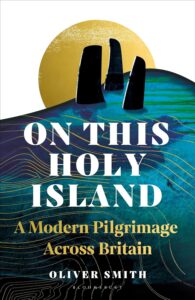Oliver Smith’s ‘On This Holy Island: A Modern Pilgrimage Across Britain’, published this week, allows us to touch what is human and relatable in the pilgrims of history, writes Beatrice Searle.

There is a wonderful sense of jeopardy in the opening of On This Holy Island. Caught in rising water on the causeway between Lindisfarne and the UK mainland, your only hope is to somehow reach and clamber into a single hut on stilts in the North sea, and there wait seven hours for the fall of the tide. ‘To cross the pilgrims’ way successfully’, Oliver Smith writes, ‘you needed to seek an alignment’. In those places that derive their sanctity from their geology, geography and proximity to the elements; on rock ridges, in caves and over mudflats, the necessity of being physically aligned seems to be part of the answer to reaching the ‘loss of mind’ that is essential if wonder and mystery is to enter. To transform. To make pilgrim.
Being very much in the quiet, wild, long-haul pilgrimage camp myself, and having eventually been made open-hearted enough by the particular conditions of my own weighted journey to be utterly changed by it, I felt like the book held its arms open to me in its early chapters. It delivered some disarmingly simple but truthful ideas, such as the perfect accord that the holy men of Lindisfarne had reached with the sea: ’These tides meant there were hours when the monks could go out into the world to spread the word and also hours when they were left alone to pray’. I know that my moving with a great stone had created similar, vital conditions of contrast between being in motion and being motionless, between participation and introspection, thus allowing the work done to do its work on me.
Yet there were moments in reading On This Holy Island when I was uneasy about an obfuscation of what I feel to be most vital in pilgrimage. ‘To make a pilgrimage now was to embark on a journey of meaning that anyone could define in their own terms…’ So many actions that have value and validity in their own right are bought under the pilgrimage banner in the book: a grief walk, a charity run, even a visit to a haunted inn or the Hogwarts Express viaduct. Duchamp says it is art so it is. I find I cannot agree, but that’s all right. These are Oliver’s honest findings on the various ways that pilgrimage is thought of today in Britain. He does point out where historical misunderstanding and wilful ignorance occur, and he does so with plain facts and returns us to the sense that we are with a sensible person. He allows into the book, because he must to give an honest picture, some of what he himself describes as ‘crappy truisms’ spoken by people who we are not very much helped to believe in. But every now and then a truly transporting, uplifting, imagination-kindling kind of a sentence, through which we touch what is human and relatable in the pilgrims of history — ‘The wind exposed the outline of Columba’s ribs’ — shakes the book for me. As did the tale of Columba who, wishing to see his friend Oran once more, had his grave opened, only to hastily call for the return of the earth to Oran’s eyes after he downplayed the wonder of death and made hell out to be not so bad either.
At no point in the book did I know what effect, if any, this ‘retracing of sacred travel across time’ was having on its seeker. In his prologue he describes the book as being ‘an effort to locate here, in my own country, that longed-for feeling — of escaping onto bright morning light, on a path named for the stars’. His effort is clear and the occasional futility of it, sad. His contributors are by no means overwhelmingly impassioned about pilgrimage, often displaying disinterest in a discovery of truth or beauty. There is no small amount of bathos in the book. The churches are locked. The sanctity of the soil is no match for climate change, the farmers do not know the legends of the fertile fields, the sacred mountain has nothing to offer. Oliver does not suggest that he himself makes any leaps of faith into the unknown during his research, but instead conducts largely a historical and social enquiry to give us an objective account of what were once the UK’s places of magic and veneration, now so often unsympathetically urbanised, lost, underfunded, undervalued, ousted or obscured. ‘I had walked the Ridgeway hoping to get a sense of prehistoric pilgrimage’ he writes, ’but I could only ever seem to glimpse it through the prism of the more recent past, coloured by the prejudices, priorities and peculiarities of others.’
Dispiriting as these bits of the book were to read, I really did appreciate Oliver Smith’s faultless writing throughout and, above all, his candour. I am grateful to have been made aware of our magic scarcity. A reading of On this Holy Island reveals that true transformation is difficult in the extreme to set in motion today. Pilgrim paths and sacred places have been allowed to fall down and fall from consciousness, and it will take deep looking and devotion to reignite them. I think we may need to fight harder than ever for the miracles and stories we surely hope to make ourselves available to receive, when we embark on pilgrimage.
*
‘On This Holy Island’ is published tomorrow by Bloomsbury. Buy a copy here (£19.00).
Beatrice Searle is an artist and stone mason. Her book ‘Stone Will Answer: A Journey Guided by Craft, Myth and Geology’ is out now in paperback. You can read Alex Woodcock’s review here.